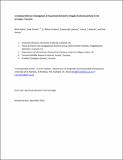Files in this item
A stated preference investigation of household demand for illegally hunted bushmeat in the Serengeti, Tanzania
Item metadata
| dc.contributor.author | Moro, Mirko | |
| dc.contributor.author | Fischer, Anke | |
| dc.contributor.author | Milner-Gulland, E.J. | |
| dc.contributor.author | Lowassa, A. | |
| dc.contributor.author | Naiman, L. C. | |
| dc.contributor.author | Hanley, Nicholas David | |
| dc.date.accessioned | 2016-02-18T14:40:06Z | |
| dc.date.available | 2016-02-18T14:40:06Z | |
| dc.date.issued | 2015-08 | |
| dc.identifier | 159055387 | |
| dc.identifier | 6d3137ac-5ab9-4840-a613-fb2bb3d7f282 | |
| dc.identifier | 84938977716 | |
| dc.identifier | 000359601500012 | |
| dc.identifier.citation | Moro , M , Fischer , A , Milner-Gulland , E J , Lowassa , A , Naiman , L C & Hanley , N D 2015 , ' A stated preference investigation of household demand for illegally hunted bushmeat in the Serengeti, Tanzania ' , Animal Conservation , vol. 18 , no. 4 , pp. 377-386 . https://doi.org/10.1111/acv.12184 | en |
| dc.identifier.issn | 1367-9430 | |
| dc.identifier.uri | https://hdl.handle.net/10023/8260 | |
| dc.description | This paper originates in a research project “Hunting for Sustainability” supported by the European Commission under the 7th Framework Programme for Research and Technological Development, and the research has been co-funded by Frankfurt Zoological Society. | en |
| dc.description.abstract | Illegal hunting for bushmeat is regarded as an important cause of biodiversity decline in Africa. We use a ‘stated preferences’ method to obtain information on determinants of demand for bushmeat and two other protein sources, fish and chicken, in villages around the Serengeti National Park, Tanzania. Our study focuses particularly on the impact of price changes, as anticipating and understanding the impact of price changes (whether caused by conservation interventions or market changes) on demand for bushmeat enables effective responses to be planned. We estimate the effects of changes in the price of bushmeat and in the prices of two substitute protein sources – fish and chicken – on household demand for bushmeat. Results suggest that increasing the availability of lower priced protein substitutes would reduce demand for bushmeat, and therefore, potentially pressure on wildlife populations. However, raising the price of bushmeat (e.g. as a result of reducing illegal hunting) would reduce household demand to a greater degree than equivalent decreases in the price of alternative protein sources. In both cases, elasticity of demand parameters are reported, which summarize the relative response to households to these alternative interventions. A 10% rise in bushmeat prices would reduce demand by around 6–7%, while a 10% fall in chicken or fish prices would reduce bushmeat demand by around 3–4%. The response to price changes varied between ethnic groups, and also according to household size (with the direction of the effect depending on whether the substitute was chicken or fish), but was not significantly affected by wealth or income. | |
| dc.format.extent | 569705 | |
| dc.language.iso | eng | |
| dc.relation.ispartof | Animal Conservation | en |
| dc.subject | Alternative protein sources | en |
| dc.subject | Conservation policy | en |
| dc.subject | Illegal bushmeat | en |
| dc.subject | Illegal hunting | en |
| dc.subject | Stated preferences | en |
| dc.subject | Price elasticity of demand | en |
| dc.subject | Serengeti | en |
| dc.subject | Tanzania | en |
| dc.subject | GF Human ecology. Anthropogeography | en |
| dc.subject | NDAS | en |
| dc.subject.lcc | GF | en |
| dc.title | A stated preference investigation of household demand for illegally hunted bushmeat in the Serengeti, Tanzania | en |
| dc.type | Journal article | en |
| dc.contributor.institution | University of St Andrews. Geography & Sustainable Development | en |
| dc.identifier.doi | 10.1111/acv.12184 | |
| dc.description.status | Peer reviewed | en |
| dc.date.embargoedUntil | 2015-12-17 |
This item appears in the following Collection(s)
Items in the St Andrews Research Repository are protected by copyright, with all rights reserved, unless otherwise indicated.

